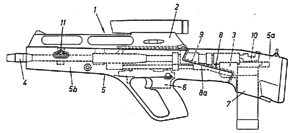Colt ACR

The Colt ACR was Colt's entry in the U.S. DoD Advanced Combat Rifle program, which concluded with the result that none of the entrants achieved enough of an improvement over the M16 to be worth the cost.
The Colt ACR was not a total loss, however; the scope went on to be offered by Elcan, a version of which was eventually adopted as the M145 Machine Gun Optic used on a number of firearms, especially those from Diemaco (now Colt Canada).
Ammunition
The key design change was the use of "duplex rounds", a single cartridge with two bullets in it. Olin Corporation produced three different rounds for testing, the first consisting of two tungsten projectiles in a long-necked case, the second used a standard-length case with two 1.7 grams (27 gr), 4.0-millimetre (0.158 in) tungsten projectiles, and the final entry was another standard-length case with two 5.7-millimetre (0.224 in) projectiles, one 2.3 grams (35 gr) the other 2.1 g (33 gr). The latter was eventually selected for submission to the ACR trials. The basic idea of the duplex load is to increase the number of projectiles fired, which is the primary determinant of battlefield casualties.[1] However, they significantly reduced accuracy, requiring the user to also carry traditional ammunition for long-range shots.
See also
- List of individual weapons of the U.S. Armed Forces
- Colt Automatic Rifle
- Project Abakan
- Buck and ball



